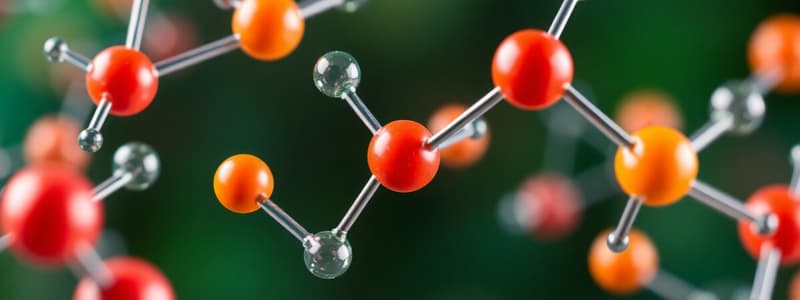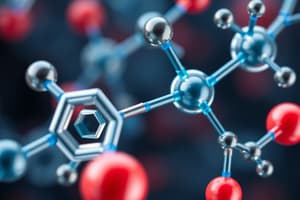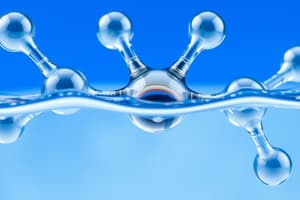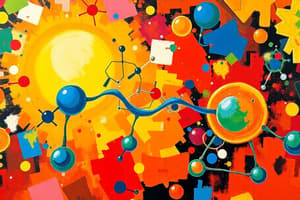Podcast
Questions and Answers
What is the final step of the scientific method?
What is the final step of the scientific method?
- Conclude (correct)
- Experiment
- Analyze
- Observe
Which of the following best describes an atom?
Which of the following best describes an atom?
- The smallest unit of life
- A type of covalent bond
- The smallest unit of matter (correct)
- A collection of molecules
What role do enzymes play in living organisms?
What role do enzymes play in living organisms?
- Provide structural support to cells
- Generate energy
- Store genetic information
- Facilitate chemical reactions (correct)
Which statement correctly describes the monomers of carbohydrates?
Which statement correctly describes the monomers of carbohydrates?
How do ionic bonds differ from covalent bonds?
How do ionic bonds differ from covalent bonds?
What is the primary function of nucleotides in organisms?
What is the primary function of nucleotides in organisms?
Which of the following best describes the unique structure of phospholipids?
Which of the following best describes the unique structure of phospholipids?
When do chromosomes condense during cell division?
When do chromosomes condense during cell division?
What is the smallest unit of life?
What is the smallest unit of life?
Which of the following best describes covalent bonds?
Which of the following best describes covalent bonds?
What do enzymes primarily do in biological systems?
What do enzymes primarily do in biological systems?
Which of these is a polymer of carbohydrates?
Which of these is a polymer of carbohydrates?
What is the main function of nucleotides?
What is the main function of nucleotides?
What is unique about the structure of phospholipids?
What is unique about the structure of phospholipids?
What are the primary functions of proteins in the body?
What are the primary functions of proteins in the body?
Which of the following describes the process of polymerization?
Which of the following describes the process of polymerization?
What are the subatomic particles found in an atom and their charges?
What are the subatomic particles found in an atom and their charges?
Which of the following is NOT a main class of lipids?
Which of the following is NOT a main class of lipids?
Flashcards
What is an atom?
What is an atom?
The smallest unit of matter, composed of protons, neutrons, and electrons.
What is a cell?
What is a cell?
The smallest unit of life, capable of carrying out basic life processes.
What is polymerization?
What is polymerization?
The process of joining monomers (smaller molecules) together to form polymers (larger molecules).
What are the monomers and polymers of carbohydrates?
What are the monomers and polymers of carbohydrates?
Signup and view all the flashcards
What are the monomers and polymers of proteins?
What are the monomers and polymers of proteins?
Signup and view all the flashcards
What are enzymes?
What are enzymes?
Signup and view all the flashcards
What are the monomers and polymers of nucleic acids?
What are the monomers and polymers of nucleic acids?
Signup and view all the flashcards
What are the main classes of lipids?
What are the main classes of lipids?
Signup and view all the flashcards
What is a covalent bond?
What is a covalent bond?
Signup and view all the flashcards
What is an ionic bond?
What is an ionic bond?
Signup and view all the flashcards
What is mitosis?
What is mitosis?
Signup and view all the flashcards
What is meiosis?
What is meiosis?
Signup and view all the flashcards
What is an enzyme?
What is an enzyme?
Signup and view all the flashcards
What is photosynthesis?
What is photosynthesis?
Signup and view all the flashcards
What is cellular respiration?
What is cellular respiration?
Signup and view all the flashcards
Study Notes
Scientific Method
- Steps: Observe, question, hypothesize, experiment, analyze, conclude.
Basic Chemistry
- Smallest unit of matter: Atom.
- Smallest unit of life: Cell.
- Atom components: Protons (+), neutrons (neutral), electrons (-).
Bonds
- Covalent bonds: Sharing electrons.
- Ionic bonds: Transferring electrons.
Macromolecules
- Carbohydrates:
- Monomers: Monosaccharides (e.g., glucose).
- Polymers: Polysaccharides (e.g., starch, cellulose).
- Functions: Energy storage, structural support, produce and store energy, structural support to cells and tissue.
- Proteins:
- Monomers: Amino acids.
- Polymers: Proteins.
- Functions: Breakdown food, growth and repair, help make up proteins by bonding numerous amino acids together.
- Nucleic Acids:
- Monomers: Nucleotides.
- Polymers: DNA/RNA.
- Functions: Store genetic information.
- Lipids:
- Classes: Fats, oils, waxes, steroids.
- Phospholipids:
- Function: Cell membrane.
- Unique features: Hydrophilic head, hydrophobic tail.
Enzymes
- Special proteins that catalyze biochemical reactions.
Cell Division Stages
- Cell Cycle: Stages involve the orderly sequences of phases leading to cell division.
- Prophase: Chromosomes condense.
- Metaphase: Chromosomes align in the center.
- Anaphase: Chromosomes separate.
- Telophase: Nuclear envelope reforms.
Studying That Suits You
Use AI to generate personalized quizzes and flashcards to suit your learning preferences.




